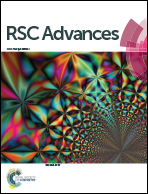Preferential (100)-oriented CH3NH3PbI3 perovskite film formation by flash drying and elucidation of formation mechanism†
Abstract
Most previous studies of perovskite films have explored the use of highly (110)-oriented perovskite films, even though films having the (100) orientation exhibit more desirable characteristics. In this study, we examined a simple method for growing (100)-oriented perovskite films for solar cells and elucidated their growth mechanism. Oriented perovskite grains with a lateral size of as much as 20 μm and a very flat surface morphology could be obtained. It was found that the amount of thermal energy delivered during annealing and the amount of residual solvent remaining after spin coating play critical roles in determining the growth orientation of the perovskite film. It was suggested that the formation mechanism of the preferentially (100)-oriented grains is most likely the classical hetero-nucleation and selective growth process in the solution system, even though DMSO was included in the solvent. The results of this study will aid in the optimization of preferentially (100)-oriented CH3NH3PbI3 perovskite film, which will be useful for the study of the effect of crystal orientation and the properties of perovskite optoelectronic devices, such as LEDs, sensors, transistors, and photovoltaic cells.



 Please wait while we load your content...
Please wait while we load your content...